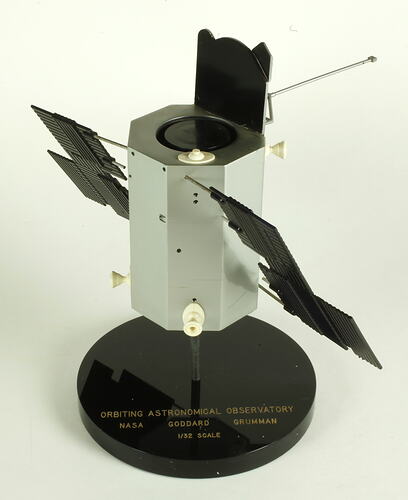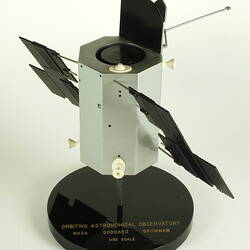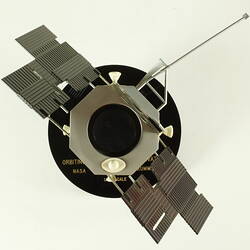Summary
Model of the Orbiting Astronomical Observatory (OAO-2) satellite, also known as Stargazer. It is a 1:32 scale model.
The actual Orbiting Astronomical Observatory (OAO-2) satellite was developed by NASA (Goddard Space Flight Centre) and manufactured by Grumman Aerospace Corporation in New York State, USA. It was launched on 7th December 1968 from the Kennedy Space Centre at Cape Canaveral in Florida, using an Atlas-Centaur launch vehicle.
There were four OAO satellite observatories launched between 1966 and 1972. The first satellite launched but then suffered a power failure requiring the mission to be terminated before it could undertake any research. It was followed up by OAO-2 described here, which was a successful mission, and then OAO-B which failed to make it to orbit. The final observatory, OAO-3 (Copernicus) was the most successful mission, launched in 1972.
The OAO-2 satellite observatory made thousands of observations in ultraviolet light. It carried ultraviolet viewing instruments supplied by the University of Wisconsin (the Wisconsin Experiment Package) and the Smithsonian Institution's Astrophysical Observatory (Project Celescope). OAO-2 contributed significantly to scientific knowledge about galaxies, stars, the solar system, and earth's upper atmosphere. It also observed comets, a nova and a supernova.
Prior to OAO-2, suborbital sounding rockets were used to undertake ultraviolet observations of stars but could only collect small amounts of data compared to the OAO-2 satellite. The OAO-2 was an important forerunner of later American space telescopes such as Hubble, Chandra and Compton.
Physical Description
Grey plastic hexagonal cylinder with two black rectangular panels, displayed on circular black plastic stand.
More Information
-
Collecting Areas
-
Acquisition Information
Donation from Unknown Source - Likely Donation
-
Designer of Item Modelled
Goddard Space Flight Centre, National Aeronautics & Space Administration (NASA), Greenbelt, Maryland, United States of America, 1968
-
Manufacturer of Item Modelled
Grumman Aerospace Corporation, Long Island, New York, United States of America, 1968
-
Inscriptions
On base of stand: ORBITING ASTRONOMICAL OBSERVATORY / NASA GODDARD GRUMMAN / 1/32 SCALE
-
Brand Names
-
Classification
-
Category
-
Discipline
-
Type of item
-
Object Dimensions
215 mm (Width), 185 mm (Depth), 200 mm (Height)
Diameter of stand: 127mm
-
Model Scale
1:32
-
References
[Link 1] accessed 10 March 2022. [Link 2] accessed 10 March 2022.
-
Keywords
Satellites, Space, Science, Research, Observatories, Space Technology, Stars, Galaxies, Comets, Rockets, Models & Modelmaking, DesignWeek2022





